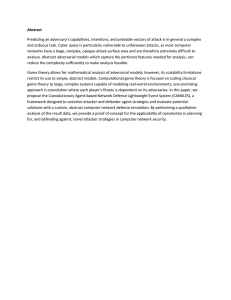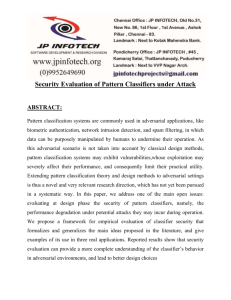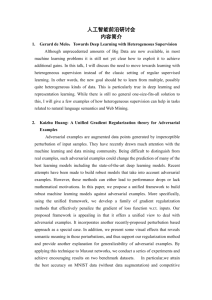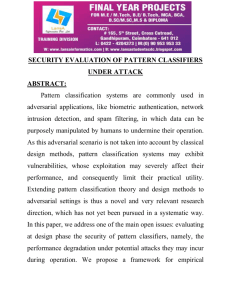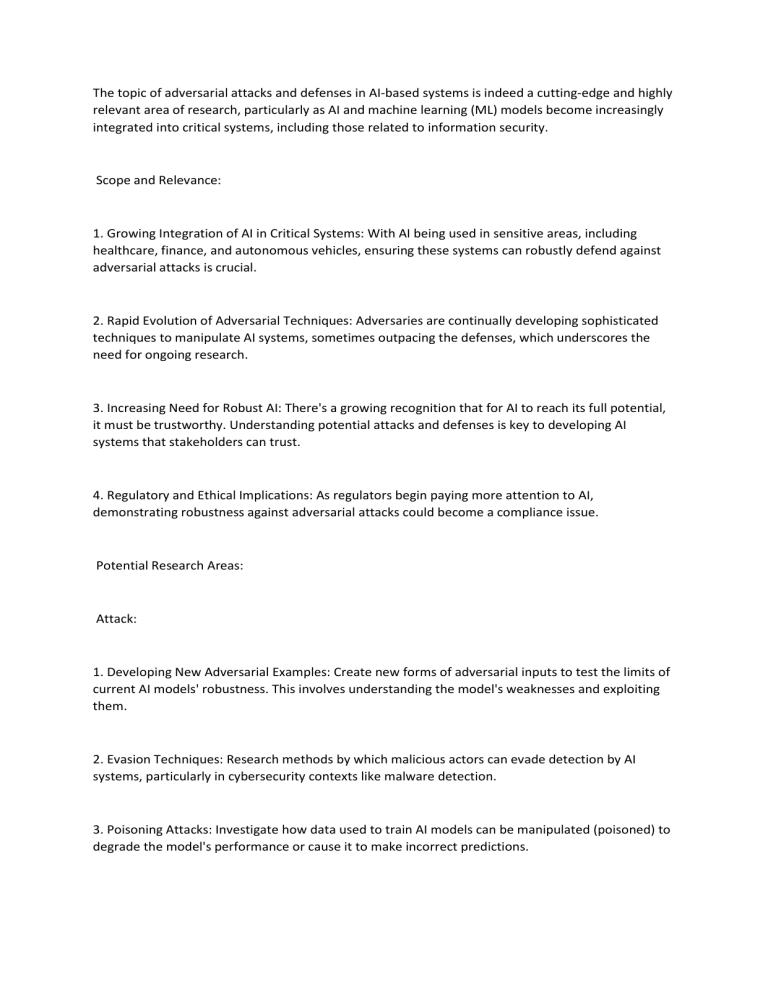
The topic of adversarial attacks and defenses in AI-based systems is indeed a cutting-edge and highly relevant area of research, particularly as AI and machine learning (ML) models become increasingly integrated into critical systems, including those related to information security. Scope and Relevance: 1. Growing Integration of AI in Critical Systems: With AI being used in sensitive areas, including healthcare, finance, and autonomous vehicles, ensuring these systems can robustly defend against adversarial attacks is crucial. 2. Rapid Evolution of Adversarial Techniques: Adversaries are continually developing sophisticated techniques to manipulate AI systems, sometimes outpacing the defenses, which underscores the need for ongoing research. 3. Increasing Need for Robust AI: There's a growing recognition that for AI to reach its full potential, it must be trustworthy. Understanding potential attacks and defenses is key to developing AI systems that stakeholders can trust. 4. Regulatory and Ethical Implications: As regulators begin paying more attention to AI, demonstrating robustness against adversarial attacks could become a compliance issue. Potential Research Areas: Attack: 1. Developing New Adversarial Examples: Create new forms of adversarial inputs to test the limits of current AI models' robustness. This involves understanding the model's weaknesses and exploiting them. 2. Evasion Techniques: Research methods by which malicious actors can evade detection by AI systems, particularly in cybersecurity contexts like malware detection. 3. Poisoning Attacks: Investigate how data used to train AI models can be manipulated (poisoned) to degrade the model's performance or cause it to make incorrect predictions. 4. Model Inversion Attacks: Attempt to reverse-engineer sensitive information from a model's parameters or its output, challenging privacy norms and model security. Defense: 1. Adversarial Training Techniques: Explore how models can be trained on adversarial examples to enhance their robustness. This could involve creating a more diverse set of adversarial training examples or developing new training methodologies. 2. Feature Squeezing and Defensive Distillation: Research methods that reduce a model's sensitivity to adversarial input changes (e.g., reducing the input space) or that use a distilled model to smooth out the decision boundaries, making it harder for adversarial inputs to find gaps. 3. Certified Defenses: Work on developing defenses that are provably secure against certain classes of attacks, moving from empirical defense to formal guarantees. 4. Detection and Mitigation: Develop systems that can detect when an input is adversarial and perhaps revert to safer, more robust models or decision processes in response. 5. Improving Model Interpretability and Transparency: Research how making AI systems more interpretable could help in detecting or defending against adversarial attacks. Thesis Project Approach: 1. Literature Review: A thorough review of the existing literature on adversarial attacks and defenses, understanding the current landscape of research, and identifying gaps. 2. Hypothesis and Methodology Development: Based on the gaps identified, develop your hypotheses and design experiments for testing. These could involve creating adversarial examples, testing them against existing models, and designing/implementing defense mechanisms. 3. Experimentation and Analysis: Rigorous testing of your attacks and defenses, followed by a comprehensive analysis of your results. This could also involve comparison with existing benchmarks in the field. 4. Real-world Implications: Discuss how your findings could apply to real-world systems, considering the practical aspects of integrating your proposed defenses into existing AI applications. 5. Recommendations for Future Work: Given that this field is rapidly evolving, it would be helpful to provide guidance on potential future research directions based on your work. Considering the dynamic and essential nature of this field, it could be an excellent choice for a thesis project. It’s advisable to consult with your academic advisor to tailor the topic to your educational program's specifics and your research interests. They might also provide insights into the availability of resources, such as datasets and computational power, which you will need for your research. Understanding adversarial neural networks and adversarial attacks requires diving into some concepts of machine learning, particularly within the context of deep learning and neural networks. Let's break down these concepts to get a clearer picture: Adversarial Neural Networks: In the context of machine learning, "adversarial" usually refers to models, techniques, or scenarios that involve opposition or competition. One of the most prominent examples of this is Generative Adversarial Networks (GANs). 1. Generative Adversarial Networks (GANs): These are composed of two neural networks, the generator and the discriminator, which are trained simultaneously through a competitive process. - Generator: This network generates new data instances that should ideally be indistinguishable from real data. - Discriminator: This network evaluates the samples it receives, which can come either from the real dataset or from the generator, and attempts to distinguish between the two sources. The two networks are trained in tandem, with the generator trying to produce increasingly convincing data, and the discriminator trying to get better at distinguishing real data from these fabrications. This adversarial process continues until the generator produces data good enough to fool the discriminator into thinking it's real. Adversarial Attacks: In the context of cybersecurity and machine learning integrity, "adversarial attacks" refer to attempts to fool machine learning models through manipulated inputs crafted to force specific kinds of misclassifications or errors in the model's output. This concept is especially pertinent in scenarios where machine learning models make critical decisions, like autonomous driving or security threat detection. 1. Crafting Adversarial Examples: These attacks involve input data that has been slightly modified in ways that might be imperceptible or irrelevant to humans but can completely throw off a machine learning model. For instance, changing a few pixels in an image of a stop sign could lead a model to classify it as a yield sign or something else entirely. 2. Purposes of Adversarial Attacks: They can be used for various purposes, including testing model robustness, privacy attacks (revealing sensitive information based on model outputs), or as part of broader attacks on systems that rely on machine learning. 3. Types of Adversarial Attacks: - White-Box Attacks: The attacker has full access to the model, including its architecture, inputs, outputs, and weights. This comprehensive knowledge is used to craft the most effective attacks. - Black-Box Attacks: The attacker has limited knowledge about the model. They don't know the specific parameters and must use trial and error to develop effective adversarial inputs. These attacks are more representative of real-world scenarios where attackers might not have inside information. 4. Attack Techniques: - Evasion: Crafting adversarial input data to fool a trained model during inference, causing it to make incorrect predictions. - Poisoning: Manipulating the training data itself so the model will learn incorrectly or make mistakes once deployed. - Model Inversion or Extraction: Trying to recreate the model (or its training data) based only on access to the model's inputs and outputs, potentially violating privacy or intellectual property rights. 5. Defense Strategies: Various techniques are being researched and developed to make models more robust against adversarial attacks, including adversarial training, input preconditioning, and architecture modifications. Adversarial attacks represent a significant challenge in deploying machine learning reliably, especially in high-stakes applications, and are thus a critical area of research in modern AI and cybersecurity. Understanding and mitigating these attacks are essential for advancing the safety and reliability of AI applications.

